LONGMONT, CO — The sounds from a shofar, a semi-musical instrument used typically in Jewish ceremonies, have been heard for thousands of years at many occasions.
Seasonal Sounds – Shofars note the beginning of High Holy Days
LONGMONT, CO — The sounds from a shofar, a semi-musical instrument used typically in Jewish ceremonies, have been heard for thousands of years at many occasions.
Its blasts have marked the beginning of creation, the revelation to Moses at Mount Sinai, the destruction of the temple, as well as the coronation of kings and the start of wars.
But the shofar (pronounced SHOW-far) is most visible, and audible, during the Ten Days of Repentance, a holy time that includes Rosh Hashana, Yom Kippur and the days in-between.
This year, Rosh Hashana, which is the beginning of the Jewish new year, begins at sundown Wednesday and Yom Kippur, or the Day of Atonement, begins at sundown Sept. 21.
Last weekend, Rabbi Yakov Borenstein of the Chabad Jewish Center of Longmont held a shofar factory at his home in preparation for this 10-day period, also called the High Holy Days.
“This is a time in the Jewish new year that we take on a resolution to be in a better place, to be full of peace and harmony,” Borenstein said. “We all have our times when we slip up a little bit and are improper, and these certain times makes us a little more humble and so we try to return to our faith and return to God.”
Participants at the event made their own shofars from animals’ horns, which Borenstein said were bought from sellers all over the world.
A shofar usually is crafted from a ram’s horn, to symbolize the sacrificial ram God provided to Abraham instead of sacrificing his own son Isaac. Borenstein said these are horns that have fallen off the animal, and not cut off, which can cause the animal pain.
But a horn from any kosher animal (except a cow) will do, Borenstein said. Cows’ horns aren’t permitted because of the Hebrews’ sin of using a golden calf idol instead of worshiping God, he added.
“The sound of the shofar reminds the Jewish people of repentance,” said Jeff Seger of Longmont, who participated in the shofar factory last weekend with his three children. “When a person hears the cry of the shofar, it represents the cry of the soul. … That means it’s time to return to God.”
At Borenstein’s home, about 30 people attended the shofar factory last weekend.
Participants chose their horns, which were then soaked in water making any cartilage inside easier to remove. Afterward, each horn was placed in a clamp so the end could be sawed off and drilled to create the mouthpiece. The horns then were polished.
Seger said his family will spend the next year perfecting their shofars at home.
“We’ll probably work on them for the next six months, polishing them and making them perfect and beautiful. And next year, we’ll get to use them for Rosh Hashana,” he said.
After the ceremonial instruments were completed, participants learned how to blow the shofars to make the traditional notes, such as tekoit (one long, straight blast), shevarim (three medium wailing blasts) and teruot (nine quick and consecutive blasts).
Borenstein said the shofar is sounded 100 times on Rosh Hashana, a day that emphasizes the special relationship between God and humanity.
“The shofar is the inner sound of the soul crying out for God … yearning for a new year and acceptance from God,” he said.











